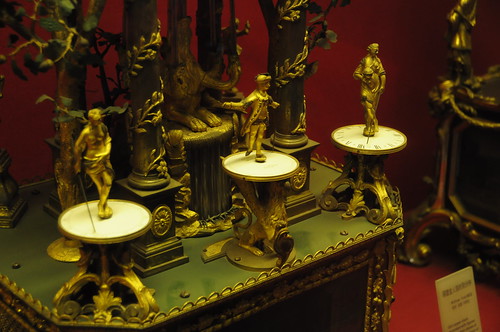The West Route consists of six western palaces and located on the west side of the three rear palaces. This area was the residential area for the imperial concubines during the Ming and Qing dynasties.
The Hall of Mental Cultivation
In the Ming Dynasty, here was one of the residences for the imperial concubines. But during the Qing dynasty because Emperor Yongzheng moved his residential area from the Palace of Heavenly Purity to the Hall of Mental Cultivation, the rest of the Qing emperors all resided here, and then here became the place where the emperors conducted state affairs and held their private audiences. As time went by, this palace had become the most important building besides the Hall of Supreme Harmony in the Forbidden City.
The central hall was the audience charmber for the emperor to read documents, to give audience to high-ranking officials and to receive important ministers. The western chamber has a special name, the "Room of Three Rare Treasures". In 1746, Qing Emperor Qianlong kept three precious outstanding calligraphies in this chamber. They were written by three famous calligraphers of the Jin Dynasty(265-420 AD), Wang Xizhi, Wang Xianzhi and Wang Xun. Emperor Qianlong gave the name "Room of Three Rare Treasures." The Eastern Chamber was the place where the well-known "Holding Court Behind the Curtain" was staged by Empress Dowager Cixi.
The Hall of Manifesting Obedience
The courtyard behid the Hall of Mental Cultivation is called the Hall of Manifesting Obedience (Ti shun tang). During the Qing dynasty, just because the third Qing Emperor Yongzheng moved his living quarters from the Palace of Heavenly Purity to the Hall of Mental Cultivation, the empress moved here. And then it became the residence of the empress.
The Palace of Gathering Elegance
Empress Dowager Cixi once lived here when she was an impreial concubine. Fortunately she gave birth to a son, and later her son came to the throne and became the emperor. Ever since then her status was enhanced.
2.The East Route
The East Route was the residential area for the imperial concubines during the Ming and Qing dynasties. Today the eastern palaces are used as exhibition halls for the traditional Chinese arts, the Clock and Watch Exhibition Hall and the Exhibition of Treasures.
 In the Clock and Watch Exhibition Hall, people can see many rare Chinese and western-style clocks and watches which were selected from the imperial collection. These clocks and watches are made either in China or in other countries such as Britain, France, Switzerland and the United States.
In the Clock and Watch Exhibition Hall, people can see many rare Chinese and western-style clocks and watches which were selected from the imperial collection. These clocks and watches are made either in China or in other countries such as Britain, France, Switzerland and the United States. There are a lot of priceless treasures from the imperial family on display in the Exhibition of Treasures. Mainly they are:
Gold Pagoda: This gold pagoda was used for keeping the remains of fallen hair of Emperor Qianlong's mother.
Jade Carving of Dayu Harnessing Floods: This is the largest piece of jade carved in the Forbidden City. It's more than two meters high and five tons in weight.
Ivory Mat: The ivory mat was made in Qing dynasty. It is woven with tiny pieces of ivory filaments, showing the high artistic level of Chinese handicrafts.
The Imperial Seals: The imperial seals were used by the emperor in the old days. They are made of gold, jade or sandalwood.
 The Gold Celestial Globe: This gold celestial globe was made in Qing Dynasty. More than 3,000 pearls are inlaid o the surface, representing the stars in heaven.
The Gold Celestial Globe: This gold celestial globe was made in Qing Dynasty. More than 3,000 pearls are inlaid o the surface, representing the stars in heaven. Zhenfei Well: This well is very famous in the Forbidden City because the imperial concubine Zhenfei was drowned in this well. Zhenfei was a concubine loved by Qing Emperor Guangxu. When the Eight Allied Forces invaded Beijing in 1900, Empress Dowager Cixi ordered the imperial eunuchs to push her into this well and to drown her. So the well is called "Zhenfei Well".
Orignal From: Main Buildings along two sides of Forbidden City
没有评论:
发表评论